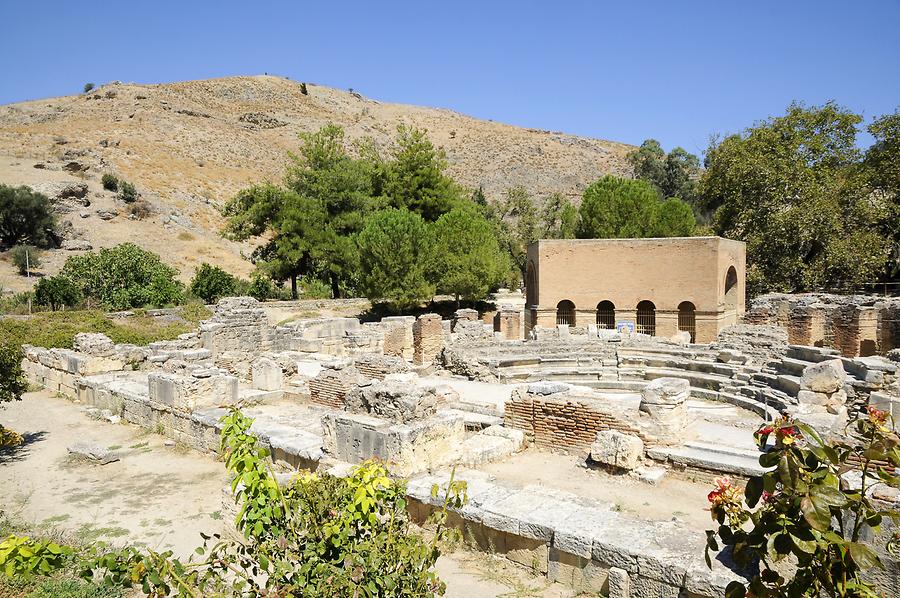Gortys#

Gortys, September 2012, © Gerhard Huber, under CC BY-NC 4.0 +Edu
In der Messara-Ebene, die schon im Altertum dicht besiedelt war, liegt Gortys
35.0630943,24.9468682
mit den Ruinen einer römischen Provinzhauptstadt. Gegründet wurde Gortys bereits im 5. vorchristlichen Jahrhundert als Zentrum einer der mächtigsten Stadtstaaten der Insel. Das Recht von Gortys diente sogar als Vorbild für viele andere Poleis Griechenlands und gilt als erster schriftlich niedergelegter Rechtskodex Europas. In 600 Zeilen wurden die Gesetze des Privat- und Strafrechts am Marktplatz öffentlich ausgestellt, sodass sich jeder Bürger über die aktuelle Gesetzeslage informieren konnte. Die Texte sind für heutige Archäologen schwer zu lesen, denn es wurden wie damals üblich nur Großbuchstaben ohne Zwischenräume verwendet. Zudem laufen die Zeilen abwechselnd von links nach rechts und von rechts nach links, wobei die rechts beginnenden Zeilen folgerichtig in Spiegelschrift verfasst sind. Man nennt dieses Schriftbild 'Boustrophedón', übersetzt 'wie ein Ochse pflügt'.
Die Rechtstexte muten erstaunlich modern an. So steht zu lesen: 'Wenn das Gesetz vorschreibt zu urteilen, soll der Richter urteilen, wie es das Gesetz vorschreibt. In anderen Sachen urteile der Richter gemäß der eidesstattlichen Zeugenaussagen.' Oder: 'Wenn Mann und Frau sich scheiden lassen, soll sie das Ihrige haben, was sie in die Ehe mitbrachte und die Hälfte des in der Ehe erarbeiteten Vermögens“'. Das Eherecht war besonders genau geregelt. Vor allem der Problematik der Mischehen zwischen Sklaven und Freien ist breiter Raum gewidmet. Je nach gesellschaftlichem Stand gab es für die gleiche Tat unterschiedliche Strafen und zwar umso strengere, je höher der Status. So wurde Ehebruch unter Sklaven mit 60 Obolen, d.h. Silbermünzen geahndet, unter Freien aber mit 600-1200. Zum Vergleich: ein Handwerker verdiente damals drei bis sechs Obolen am Tag.
Übrigens: Das Wort 'Obulus' für eine Silbermünze leitet sich vom Wort obelos, d.h. 'Spieß' ab. Bevor Münzen rund und mit Bild geprägt wurden, verwendete man kleine spitze Metallstückchen als Zahlungsmittel, daher der Name.
In the Messara plain, which was densely populated in antiquity, lies Gortys
35.0630943,24.9468682
with the ruins of a Roman provincial capital. Gortys was founded as early as the 5th century BC as the center of one of the most powerful city states of the island. The law of Gortys even served as a model for many other city-states of Greece and is considered the first written legal code of Europe. In 600 lines, the laws of private and criminal law were publicly displayed on the marketplace, so that every citizen could inform themselves about the current legal situation. The texts are difficult to read for today's archaeologists, since it was common back then to use only capital letters without spaces. In addition, the lines run alternately from left to right and from right to left, with the right beginning lines are logically written in mirror writing. This typeface is called 'Boustrophedón', translated 'how an ox plows'.
The legal texts seem surprisingly modern. Thus it is to be read: 'If the law prescribes to judge, the judge should judge, as the law prescribes. In other matters the judge judges according to the sworn testimonies. ' Or: 'If a husband and wife divorce, they should have what they have brought into marriage and half of the wealth attained during marriage'. The marriage law was particularly well regulated. Above all, the problem of mixed marriages between slaves and free is devoted to wide space. Depending on the social status, there were different penalties for the same act, and more stringent with higher the status. Thus, adultery was punished among slaves with 60 obols which were Silver coins, but among free ones with 600-1200. For comparison: a craftsman at that time earned three to six obols a day.
By the way: The word 'obulus' for a silver coin is derived from the word obelos, which means 'pike'. Before coins were milled round and with a picture, one used small pointed pieces of metal as a means of payment, hence the name.